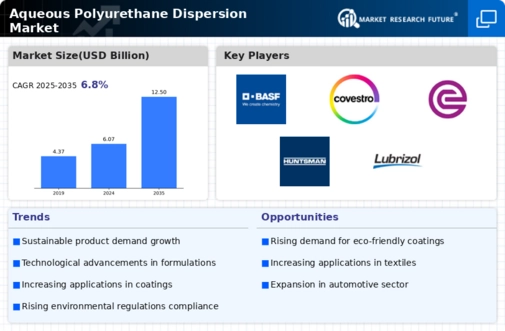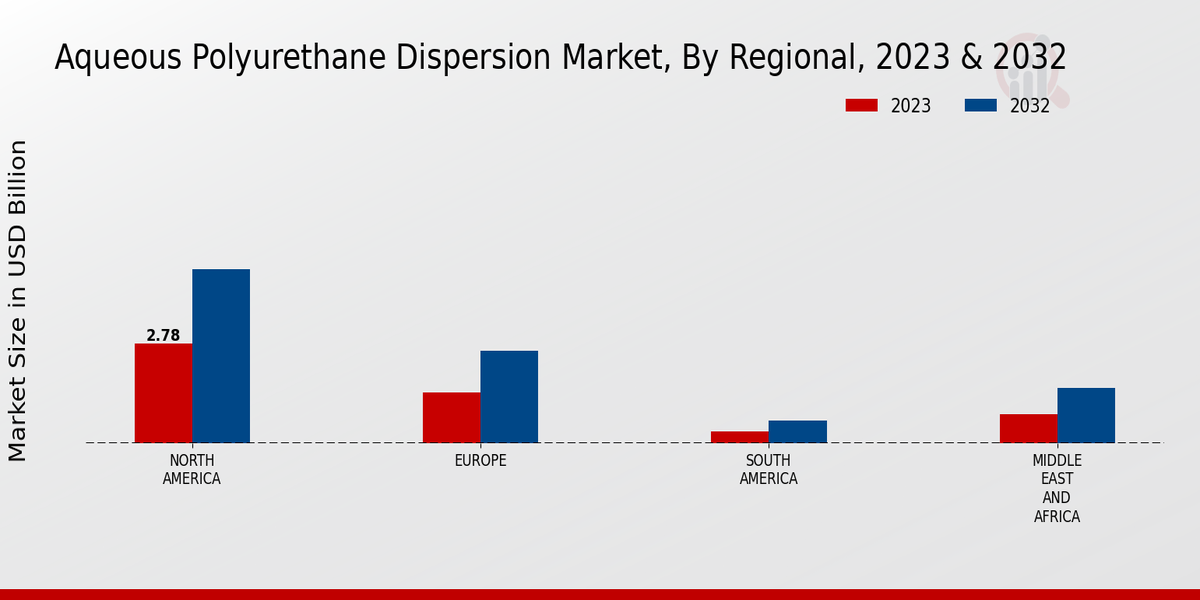Market Growth Projections
The Global Aqueous Polyurethane Dispersion Market Industry is projected to experience substantial growth over the next decade. With a market value of 6.07 USD Billion in 2024, it is anticipated to reach 12.5 USD Billion by 2035. This growth trajectory reflects a compound annual growth rate (CAGR) of 6.77% from 2025 to 2035. Such projections indicate a robust demand for aqueous polyurethane dispersions across various sectors, including automotive, construction, and textiles. The increasing emphasis on sustainability and compliance with environmental regulations further supports this positive outlook, suggesting a dynamic and evolving market landscape.
Rising Environmental Regulations
The Global Aqueous Polyurethane Dispersion Market Industry is significantly influenced by stringent environmental regulations. Governments worldwide are implementing policies that promote the use of water-based coatings over solvent-based alternatives, which are often harmful to the environment. This regulatory push encourages manufacturers to adopt aqueous polyurethane dispersions, which are less volatile organic compound (VOC) emitting. As a result, the industry is likely to witness increased investments in research and development to innovate and improve product offerings. The anticipated growth in the market, projected to reach 12.5 USD Billion by 2035, underscores the importance of compliance with environmental standards.
Expanding Applications in Construction
The Global Aqueous Polyurethane Dispersion Market Industry is benefiting from expanding applications in the construction sector. Aqueous polyurethane dispersions are increasingly used in adhesives, sealants, and coatings, providing superior performance characteristics such as water resistance and flexibility. As the construction industry continues to grow, driven by urbanization and infrastructure development, the demand for these dispersions is expected to rise. This trend is further supported by the industry's projected compound annual growth rate (CAGR) of 6.77% from 2025 to 2035, indicating a robust market outlook. The versatility of aqueous polyurethane dispersions positions them as a preferred choice in modern construction practices.
Increased Focus on Sustainable Products
The Global Aqueous Polyurethane Dispersion Market Industry is witnessing a heightened focus on sustainability, driven by consumer preferences and corporate responsibility initiatives. Manufacturers are increasingly prioritizing the development of eco-friendly products that minimize environmental impact. Aqueous polyurethane dispersions, being water-based and low in VOCs, align well with these sustainability goals. This shift is not only beneficial for the environment but also enhances brand reputation and customer loyalty. As sustainability becomes a key differentiator in the market, the industry is likely to see accelerated growth, with forecasts suggesting a significant increase in market value by 2035.
Growing Demand in Automotive Applications
The Global Aqueous Polyurethane Dispersion Market Industry experiences a notable surge in demand from the automotive sector. Aqueous polyurethane dispersions are increasingly utilized in automotive coatings due to their excellent adhesion, flexibility, and durability. As manufacturers strive to enhance vehicle performance and aesthetics, the adoption of these eco-friendly coatings is expected to rise. In 2024, the market is projected to reach 6.07 USD Billion, driven by the automotive industry's shift towards sustainable materials. This trend aligns with global initiatives aimed at reducing environmental impact, suggesting a robust growth trajectory for the industry.
Technological Advancements in Product Development
The Global Aqueous Polyurethane Dispersion Market Industry is experiencing a wave of technological advancements that enhance product performance and application versatility. Innovations in formulation and processing techniques are leading to the development of high-performance aqueous polyurethane dispersions that cater to diverse industrial needs. These advancements not only improve the physical properties of the products but also expand their applicability across various sectors, including textiles and packaging. As manufacturers continue to invest in technology, the market is poised for growth, with projections indicating a potential doubling in size by 2035. This evolution reflects the industry's commitment to meeting evolving consumer demands.

















Leave a Comment